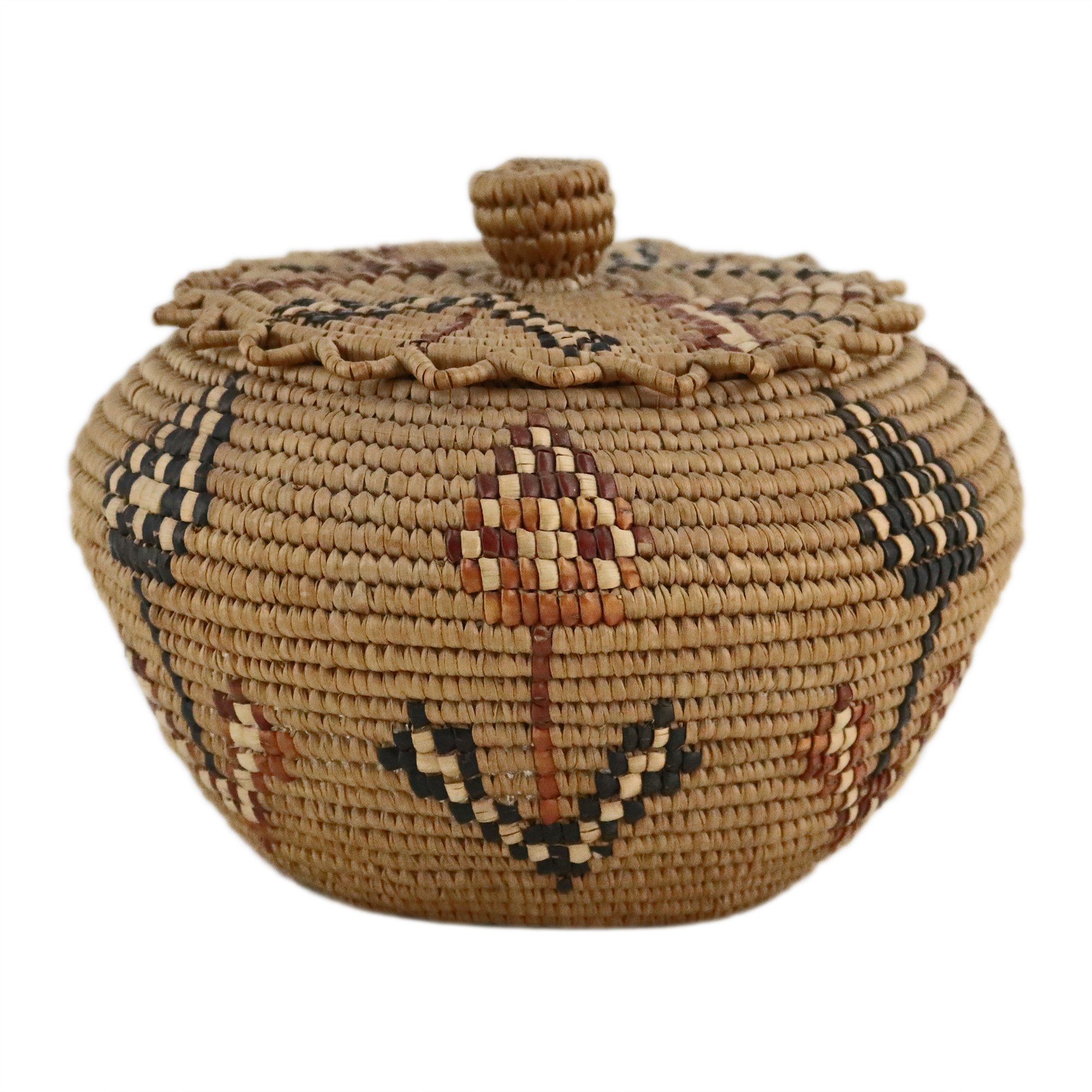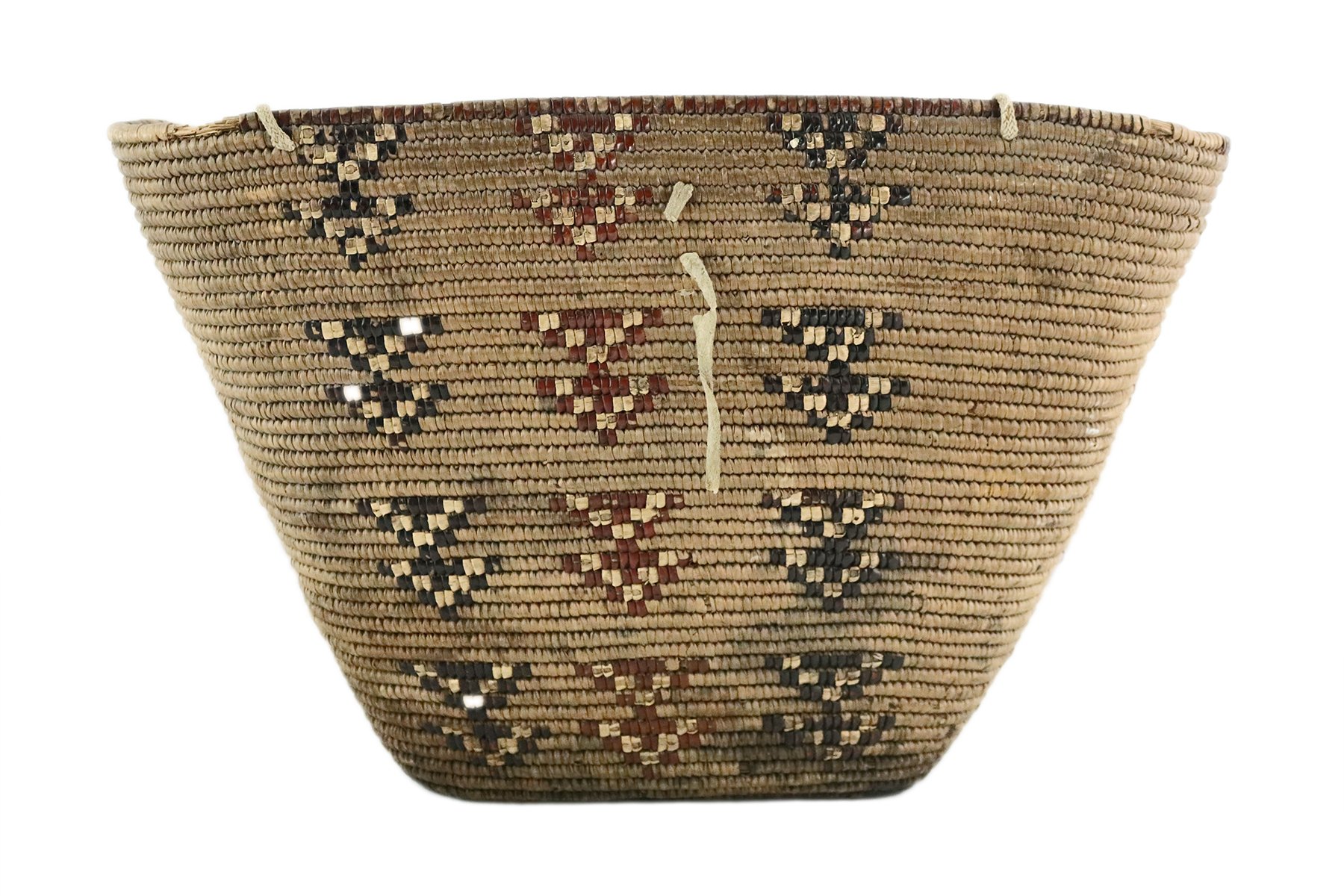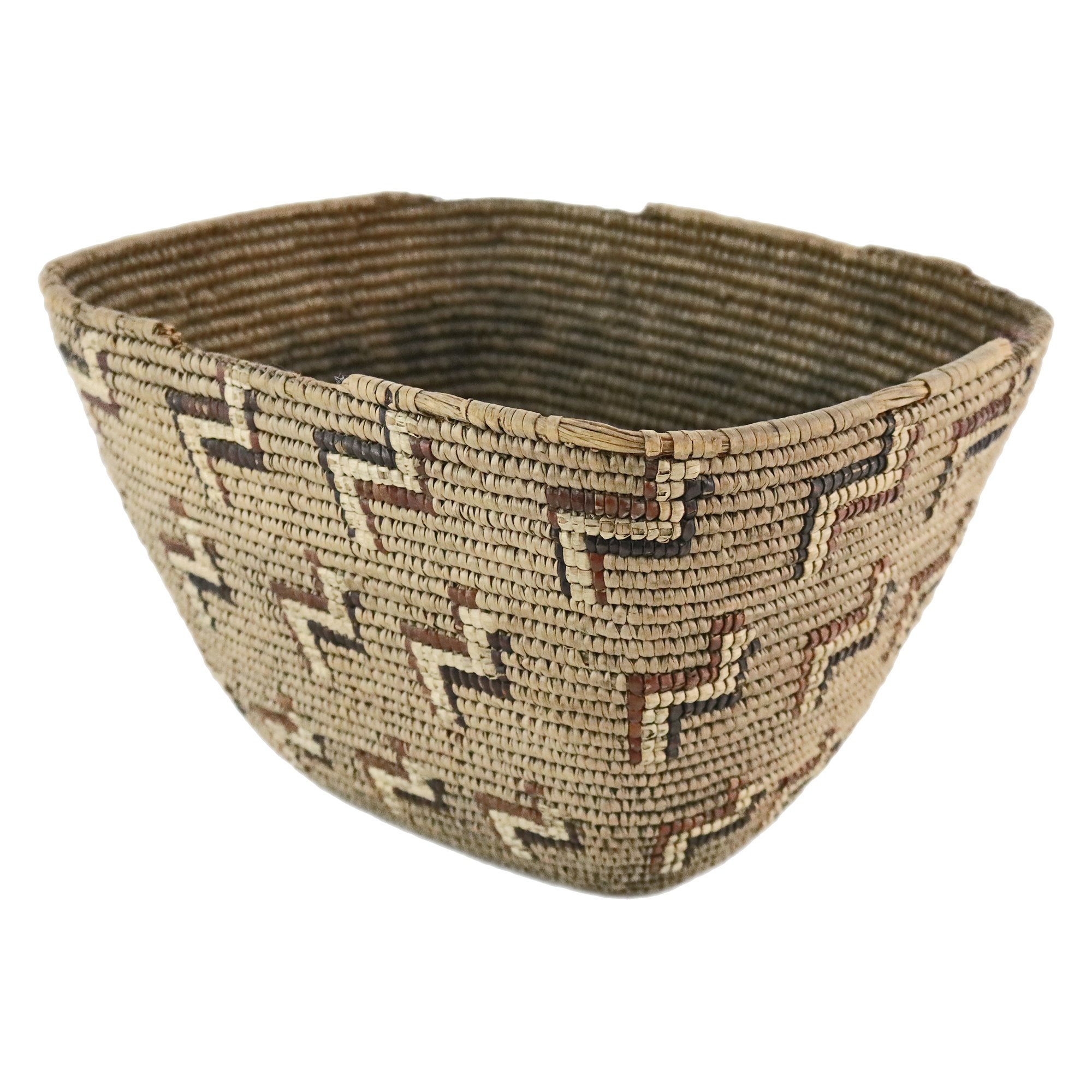NORTHWEST COAST EXHIBITION FROM A RARE PRIVATE COLLECTION
Uno Langmann Limited is pleased to announce a selling exhibition of a rare Northwest Coast private collection. Carefully assembled during the 1960s and 1970s, it is rare to see a private collection of such significance and quality, spanning over a century and including such a diverse range of artists. Many works were purchased directly from the artists and the collection has never before been exhibited or seen publicly.
William (Bill) Ronald Reid (Canadian, 1920-1998)
Leaping Killer Whale
Sterling silver sculpture, edition #1 of 10 in silver, mounted on argillite base, marked "Sterling/Reid '72/1/10"
Created in 1972, based on the Killer Whale Box with Beaver and Human, 1971, in the Collection of the Royal BC Museum, Victoria (13902) worked in gold which was for the travelling exhibit "The Legacy". The sculpture is shaped using the lost wax method.
References:
Canadian Museum of Civilization (#VII-8-1587 S82-261)
Provenance:
Purchased at Arts of the Raven Shop September 1972
Private Collection, B.C.
Size in inches: 3.25 h x 1.75 w x 2.5 d
R20406
William (Bill) Ronald Reid (Canadian, 1920-1998)
William (Bill) Ronald Reid was born in Victoria, B.C. in 1920 and raised without knowledge of his Haida heritage. He first visited his ancestral home of Skidegate in his early twenties, where he spent time with his maternal grandfather Charles Gladstone who instructed him in Haida art, and from whom he inherited the tools from his great-great uncle Charles Edenshaw. He worked for ten years in Toronto as a CBC Radio announcer while studying jewellery making at Ryerson University; his first piece of jewellery was a bracelet inspired by one worn by his maternal aunt.
Upon returning to Vancouver Reid established a studio on Granville Island and studied the artwork of Charles Edenshaw. During this time he strove to salvage artifacts and poles from ancient abandoned villages. He began making jewellery in silver and gold, gradually exploring and creating larger carvings in bronze and wood. He strove to express his ancestral Haida mythological forms in a contemporary form.
Bill Reid’s most important commissions include the monumental sculpture “The Spirit of Haida Gwaii - The Black Canoe” for the entrance court of the new Canadian Embassy in Washington, D.C., “Chief of the Undersea World” installed at the Vancouver Aquarium depicting a reaching orca, and “Raven and the First Men” based on the Haida legend and unveiled at UBC’s Museum of Anthropology in 1986. He died of Parkinson’s Disease on March 13, 1998; in his honour the cedar canoe he carved for Expo 86 was paddled along the Pacific Coast to bring his ashes to be buried in his ancestral village of T’anuu.
Robert Davidson (Haida/Canadian, b. 1946)
Robert Charles Davidson, G̲uud San Glans (Eagle of the Dawn) of the Eagle Clan, was born in Hydaburg, Alaska in 1946 and was raised in Old Massett, Haida Gwaii. His father, Claude Davidson, and Grandfather, Claude Davidson Sr., began Robert’s carving career in wood and argillite when he was 13 years old. He was majorly influenced by his great-grandfather Charles Edenshaw and his grandmother Florence Davidson who had 13 children, providing a large number of ‘aunties’ to whom Robert was very close.
It was necessary to move to Vancouver in 1965 for Robert to complete high school, and it was there that he learned to produce silkscreen prints. and has produced a wide body of prints, and at this time began producing jewellery. In 1966 he was demonstrating carving at Eaton’s Department Store where he met Bill Reid, with whom he would develop a lasting relationship. Robert moved into Bill Reid’s studio where the apprentice made his own tools and would learn the fundamentals of two-dimensional design.
In 1967 Robert attended the Vancouver School of Art (now Emily Carr University) and was swept up in the 1960’s abstract and modern art scene. He enrolled in a jewellery course where he began experimenting with abstraction, which also influenced his print making. He taught for six months in 1968 at ‘Ksan, a reconstructed village near Hazelton, and in 1969 he returned to Masset where he carved and erected a forty-foot totem pole, the first to be raised in Haida Gwaii in almost a hundred years. During this time his reputation spread and he was regularly commissioned for poles, masks, carvings prints and jewellery in silver and gold.
Robert Davidson is best known for his thorough understanding and mastering of traditional Haida sculpture and design. He is celebrated for his fine craftsmanship as well as his understanding of Northern two-dimensional design. Widely recognized, his carvings, prints, paintings and jewellery can be found in major collections and institutions worldwide.
Emily Carr (Canadian, 1871-1945)
John Livingston (Adopted Kwakwaka'wakw (Kwakiutl), 1951-2019)
John Livingston was born in Vancouver in 1951 but moved to Victoria when he was very young. He began carving at a early age at Thunderbird Park, Royal B.C. Museum. At the time Henry and Tony Hunt were head carvers at the museum and were instrumental in teaching Livingston to carve. After graduating from high school he began a full time apprenticeship under Tony and together they opened Arts of the Raven Gallery. The Gallery was a major force in Northwest Coast Native art for over 20 years. They organized international exhibitions and the gallery workshop trained many of the Kwakwaka'wakw (Kwakiutl) artists working today.
John Livingston (Adopted Kwakwaka'wakw (Kwakiutl), 1951-2019)
Frog Bowl
Carved cherry bowl, inscribed "John Livingston '74", painted with black, red and green, carved from an old piece of previous owner's cherry tree (Patterson Avenue, Vancouver), note crack to back leg
Provenance:
Purchased directly from the artist April 1974
Private Collection, B.C. (227)
Size in inches: 3.5 h x 9 w x 5.25 d
P20427
John Livingston (Adopted Kwakwaka'wakw (Kwakiutl), 1951-2019)
Kwakiutl Sea Otter Feast Dish with Ladle
Wooden feast dish with matching ladle, carved and painted in red, green and black, depicting a sea otter laying on its back with its tail curled up, the bowl in its belly, inscribed "John Livingston 1974 Kwakiutl Sea Otter Feast Bowl"
Provenance:
Purchased directly from the artist April 1974
Private Collection, B.C. (242)
Size in inches: 6 h x 19 w x 8 d
P20428
Henry Hunt (Mu-Bin-Kim) (Kwakwaka'wakw (Kwakiutl), 1923-1985)
The Kwakiutl artist Henry Hunt was born in Fort Rupert, Vancouver Island, B.C. He began as a part time carver in 1954 at the BC Provincial Museum and became chief carver in 1962 after the death of Mungo Martin. He worked with the Museum until 1974, much of the time spent carving totem poles with his mentor Mungo Martin and later with his eldest son Tony Hunt. He carved both for traditional ceremonial use as well as for sale. In 1970-71, Henry Hunt along with his son Tony Hunt carved a memorial 35-foot totem pole to Mungo Martin, the first pole to be erected in the Alert Bay graveyard in many years. Henry Hunt is revered as a totem carver, designer and carver of monumental Kwakwaka'wakw (Kwakiutl) sculpture.
Henry Hunt (Mu-Bin-Kim) (Kwakwaka'wakw (Kwakiutl), 1923-1985)
Potlatch Feast Dish
Carved cedar wood feast dish, depicting a wolf sitting with bowl in his back, unsigned
Provenance:
Purchased at Cowichan Trading Co., Victoria circa 1965
Private Collection, B.C. (108)
Size in inches: 8.5 h x 20 w x 7 d
P20423
Argillite Poles
Ron (Gitkinjuaas) Wilson (Haida/Canadian, b. 1945)
Argillite Beaver Totem
Argillite pole inscribed "Gitsgah 1972", refined three dimensional figure of Beaver with figure
Provenance:
Purchased at Sasquatch Trader, Victoria, September 1972
Private Collection, B.C. (61)
Size in inches: 5.5 h x 2.25 w x 2.6 d
P20414
Pat McGuire (Haida, 1943-1970)
Patrick Samuel McGuire of the Staastas Eagle Clan was born and raised in Skidegate, Haida Gwaii on June 5, 1943. His parents, Nora Tulip (Haida), and Samuel McGuire (Ojobwa-Irish), had five children of which Patrick was the eldest. An introvert, he was mainly self taught, reading the books of Marius Barbeau and looking at old family photographs. He was instructed about Haida art and culture by his uncle Joe Tulip, and enjoyed studying the Edenshaw bracelets of his aunts. A descendant of the Haida artist Charles Gladstone, Pat was attracted to argillite and began carving, drawing and painting at an early age. He developed a clean and distinctive carving style with sweeping lines. As his father was not Haida his mother lost her First Nation’s status when she married, which impacted Patrick’s right to access argillite, and he therefore had to obtain special permission to mine the precious stone. Although he is best known for his work in argillite, he was also a talented jeweller and painter, one of the few early Northwest Coast artists to produce paintings on a regular basis.
Pat moved to Vancouver at the age of nineteen and established an unofficial school of carving, teaching and influencing artists including Pat Dixon, Denny Dixon, Ron Russ, Alfred Collins and Doug Wilson. During his time in Vancouver, Pat slipped into an addiction and although he was still able to work the addiction eventually took his life. He died in December of 1970 of an overdose, at the age of 27. Despite his short career, he left behind a tremendous amount of work and is still highly regarded for his intricately detailed artwork.
Gordon Cross (Haida/Canadian, 1911-?)
Gordon Cross was born in 1911 on the Skeena River. He was the son of John Cross, Chief of Skidegate, a master carver whose work in wood, argillite, silver and gold is highly sought after.
Gordon Cross began carving in argillite circa 1940. After an accident which prevented him from fishing, he began carving jewellery in silver and gold in 1965. He became a respected Haida master carver living and working in Skidegate and was very successful professionally. He went on to influence and inspire many young Haida carvers who he apprenticed.
Northwest Coast Baskets
Round Salish lidded cedar root basket, the lid with knop and fluted openwork edge, partially decorated with flower pattern in brown and white and black and white, possibly Thompson River, early 20th century
Provenance:
Purchased at Cobweb Corner, Lumsden, July 1973
Private Collection, B.C. (420)
Size in inches: 6 h x 7 w x 7 d
P20455
Fine fully imbricated round Salish lidded cedar root basket, complete with leather handles. Fully imbricated in white with pattern in red and black, pattern is repeated 5 times around the basket in three rows, with label inside "Calder Collection Revelstoke made approx 1914"
Provenance:
Calder Collection Revelstoke
Purchased at Cabin Crafts circa 1967-68
Private Collection, B.C. (26)
Size in inches: 5.5 h x 8.5 w x 8.5 d
P20448
Unusual Mt. Currie large cedar root berry basket complete with tumpline, with leather loops in four corners and center holding the woolen tumpline decorated with imbricated pattern in red, black and white checker form, early 20th century
Provenance:
Mrs. August Jack, North Vancouver
Purchased at Cabin Craft circa 1967
Private Collection, B.C. (56)
Size in inches: 9.75 h x 12.75 w x 9.75 d
P20479
Large Salish cedar root berry basket or burden basket, with partial imbrication in a layered arrow pattern, circa 1900. Some staining and slight breaks to the rim and bottom, handles missing.
Provenance:
Purchased at Cabin Craft May 1969
Private Collection, B.C. (324)
Size in inches: 12 h x 18 w x 13 d
P20483
Tlingit spruce root circular rattle top basket, with straight side, decorated with red and purple diamond pattern, the hollow knob handle on the center of the lid filled with small pebbles, slight damage to rim of lid, early 20th century
Provenance:
Purchased at Cabin Craft, February 1970
Private Collection, B.C. (316)
Size in inches: 3 h x 4.25 w x 4.25 d
P20442
Artwork
Walter Joseph Phillips (Canadian 1884-1963)
Mount Cathedral From Lake O'Hara, B.C.
Woodblock print in colour, numbered in pencil lower left "80" and signed in pencil lower right "WJ Phillips", likely from Ten Canadian Colour Prints portfolio of 1927; watercolour and print illustrated in Walter J. Phillips
Size in inches: 7 h x 8.6 w (with frame: 13.5 h x 14.75 w)
J20495
See more items here.
































